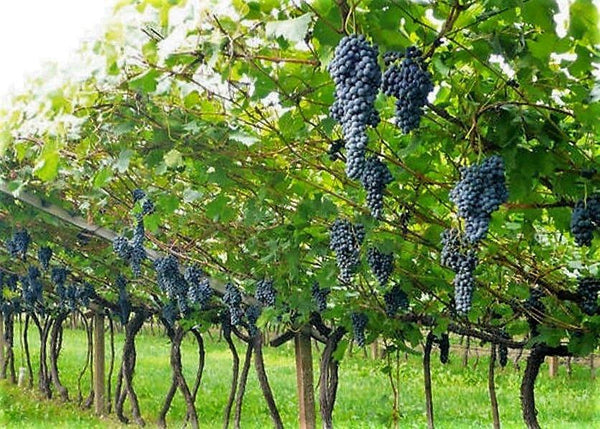
Vine training systems
Apr 15, 2022
1 comment
Before starting to talk about the vine growing systems, let's get to know better the grape and its composition. The SKIN is the external part of the berry, also called exocarp or harpoons; it can be white / yellow or black / red, and is rich in aromatic and coloring substances, including tannins. It is thanks to them that during maceration, kept in contact with the juice, the extraction of the substances contained is favored, which will then define the color and part of the aromas of the wine. Another important function of the peel is to retain the yeasts involved in fermentation.
Lapart from the most important part for us, is the pulp, it is above all rich in water and contains many substances among which the main ones are: sugars, tannins, mineral salts, acids, vitamins and aromatic substances. Thanks to these substances the main organoleptic characteristics of a wine are determined.
Then we find the VINACCIOLI, that is the seeds placed in the center of the grape, which can be 4 or less up to a minimum of 1. They are covered with cells (endocarp) and, like the skins, are rich in tannins and are involved in winemaking process. In order not to exceed the tannic concentration, and to extract only the part of the useful substances, they must be progressively eliminated before the vinification begins.

The grape represents the fruit of the vine, and the product obtained from its pressing is called must and can be obtained by pressing the grapes with or without stalks. Through crushing or pressing, a natural alcohol content juice is obtained which does not exceed 8% by volume.
As early as 7000 BC traces of viticulture were discovered between the mountainous area of the Caucasus and the countries of North Africa, such as Egypt; but it is likely that it was cultivated much earlier. Evidence was found of what were at that time, ancient drinks attributable to the ancestor of wine; but to have a real European vineyard, it will be necessary to wait until the early 1900s.
In previous centuries, calamities and parasites such as phylloxera destroyed a large part of the vineyards of the whole European continent, creating no small concern among the winemakers who found themselves with nothing in hand.

To save the situation, it was the American vine, used as rootstock as it is immune to phylloxera.

After this very brief historical mention, let's move on to analyze the location and the ideal conformation of the land for the cultivation of the vine. Let's start with the soil analysis; the best characteristics it requires are: to be medium-textured with a pH varying between 6.5 and 7.5; to be sufficiently distant from the extremes of the planet, represented by the South Pole and North Pole, as well as from the Equator; and the choice of hilly terrain to avoid water stagnation. The vine must also be well exposed to the sun for proper ripening. After choosing the best location, the soil must be well shredded and thoroughly softened; consequently the cuttings will be planted.
Once the vineyard has been obtained, the winegrower will have to establish the training system based on the vine planted, the slope of the land and the product to be obtained. By training systems we mean the support structures for the vine, as well as the pruning schemes, useful for reducing and conditioning the vegetative growth of foliage and shoots.
The vineyard requires special care in order to produce good quality wines; over the years, in fact, the ways of growing the vine have been selected and improved to obtain greater quantity and quality of the grapes. The vine bears fruit exclusively on the shoots of the year, preferably emitted from buds of the previous year.
Among the most widespread farming systems we find:
GUYOT
AND' a method based on three phases:
1. PAST phase during which the shoots that have fructified the previous season are eliminated
2. PRESENT or the set of vegetation on which pruning will be carried out
3. FUTURE phase that allows you to prepare the plant for the year to come
Eventually all the vegetation will be eliminated except a one-year-old shoot (head with fruit) and a small spur of reduced size, with two or three buds.

ARCHETTO
It is a Guyot variant in which the fruiting head is renewed annually with the production pruning.

PERGOLA
A method used for the cultivation of vines in hilly areas of the northern regions, and traditionally for the most popular grape variety since it facilitates the mechanized management of the plants, thus allowing to obtain large quantities of product. The vegetation extends over an inclined oblique plane.

TREE
It is a type of farming capable of developing reduced vegetation, in order to adapt the vineyard to unfavorable soil conditions and strong wind. It is a system that does not require support scaffolding, more widespread in southern Italy and also in Sicily.

SPERONED CORD
This form of training is suitable for vineyards based on total mechanization, suitable for a large production of wine. It foresees the presence on the plant of one or two branches with four spaced spurs, and then renew them year by year.

Whatever the type of soil and the relative breeding system chosen on the basis of the territorial conformation, the wine produced will certainly be characterized by exceptional quality and flavors, each of which will reflect unique characteristics to the sip to be discovered.
-----
Wine is a living liquid that does not contain preservatives. Its life cycle includes youth, maturity, old age and death. If not treated with reasonable respect, he falls ill and dies. (Julia Child)
-----






 Include a free greeting card by writing your message in the dedicated field at Checkout
Include a free greeting card by writing your message in the dedicated field at Checkout






1 comment
Adriano
Interessante e ben spiegato